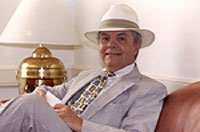 |
The Carroll Cutler House from the 1916 Catalog.
It was then used as a dormitory. |
It was 100 years ago on September 12, 1916 that Western Reserve Academy reopened as a coed boarding school. The school had closed down in June, 1903 because of bankruptcy, and alumnus James W. Ellsworth rescued the campus in 1912 by lifting the mortgage, buying the entire campus, launching a restoration effort for the historic buildings, and constructing Seymour Hall as the new “recitation center” for the school. Students have been learning in the classrooms of Seymour Hall for a century. The building itself is scheduled for a major renovation that will begin in the spring of 2017.
 |
Harlan N. Wood at his desk in Seymour Hall.
Faculty member, 1893-1903; 1916-1945 |
When Western Reserve Academy reopened in the fall of 1916, there was a small faculty that served the student body which numbered just over 50. William Sands Morley of Idaho was the new Principal, but did not last the entire year, and Harlan N. Wood, a member of the class of 1888 and a faculty member before the 1903 closing, took over the school until another WRA alumnus, Homer Oscar Sluss, could come from Covington to take over the headship of the school in 1917. He would remain through 1924. Mr. Wood would remain on the faculty until his unexpected death in early 1945.
 |
The Nutting House on Hudson Street from the 1916 Catalog.
It would be the school dining hall until 1922. |
The catalog for 1916 tells the story of renewal and hopes for the future. It notes that the school boasts a “splendid new main building”, a new athletic field, the restoration of all the historic buildings, and an endowment of $200,000, provided by the benefactor, James W. Ellsworth. New trees had been added to the “fine old elms already standing” to make the entire campus beautiful once again. The school had a Board of Trustees that included William M. Fincke of New York, stepson of Ellsworth, and local entrepreneurs and community activists Frank A. Seiberling of Akron, Warren Bicknell and John L. Severance of Cleveland. The catalog concludes that with such strong backing and in such a setting, “a high and fine educational purpose will be accomplished.” Estimated total costs for a boarding student in 1916 was placed at $255 per year.
 |
Morley Cottage on Hudson Street from the 1916 Catalog.
It was a faculty residence. |
The photos that accompany this article, except for the one of Harlan N. Wood, are from the 1916 catalog of Western Reserve Academy.




